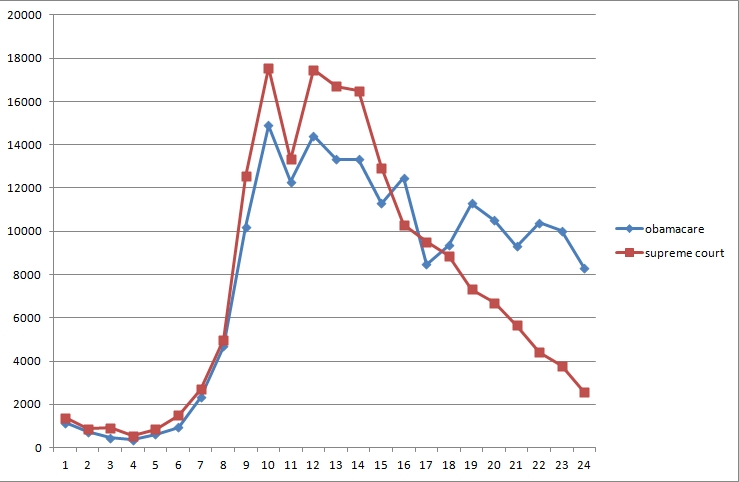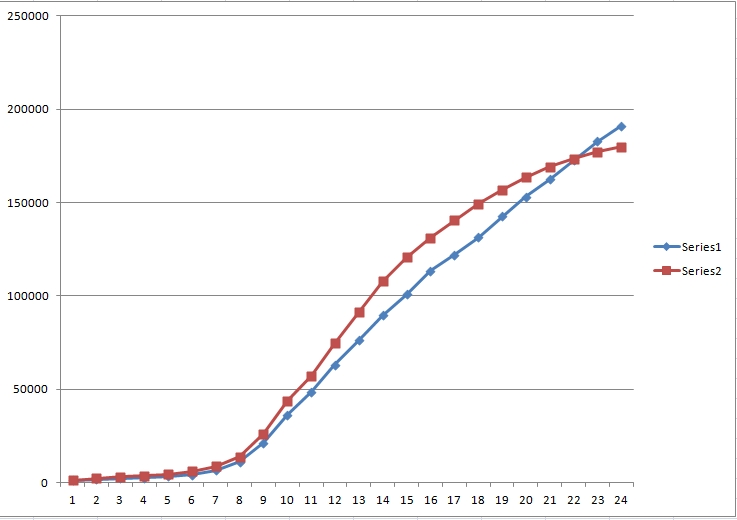
Supreme Court and Health Care; Tracking the focus of attention
What are people paying attention to in politics? We do not have to ask them. They are happy to tell the world. All we have to do is be observant enough to gather the right messages.
The Supreme Court let it be known that it would announce its decision on the Patient Protection and Affordabe Care Act, which had come to be known as Obamacare. The day of the announcement came, and the entire country seemed to be anticipating and commenting on the decision of the Court and the law. And Twitter was an important venue in which people were expressing their thoughts about this bit of our politics.
Twitter documented the velocity of the stream. [Fitzpatrick, 6/29/2012] It was a huge outpouring of thoughts. My interest was in taking it apart. Could one track a changing focus of attention in the stream. Twitter lumped together all of the messages they believed were relevant to the decision. I did several searches instead of attempting to capture them all in a single search.
The two searches that are relevant here are a search for 'supreme court' and a search for 'obamacare'. These were independent searches. I collected 191,062 messages during the twenty-four hours of June 28 that included the term obamacare. And I collected 179,849 messages containing supreme court. It is important to understand that these are small samples of the total stream of messages. However, they are impressively large as samples go. Others were happy to characterize the stream with samples of 500 or so. [Klapper, 7/2/2012]
One way to look at the results is to plot the number of messages per hour.
 |
Red is for the number of messages containing Supreme Court each hour, and blue is the number of messages containing obamacare each hour. Between 12:00 a.m. and 6:00 a.m. there are few messages since most people are asleep. But the numbers grew rather quickly after that. Each hour through 3:00 p.m. there were more messages mentioning the Supreme Court than the number of messages mentioning obamacare. After that Twitter messages containing Supreme Court fell almost as fast as they rose in the morning. But messages referring to obamacare stayed in the 8,000 to 11,000 range until midnight. In the middle of the day there were more messages mentioning the Court than obamacare. The numbers were:
Hour |
Supreme Court |
Obamacare |
9:00 |
12531 |
10203 |
10:00 |
17545 |
14890 |
11:00 |
13326 |
12285 |
12:00 |
17472 |
14406 |
13:00 |
16687 |
13331 |
14:00 |
16497 |
13324 |
From then until 18:00 the number of messages were in the same range. It is only after 6:00 p.m. that the two streams diverge. The Supreme Court had spoken and attention turned to what it meant for health care and the politics surrounding health care reform.
A second way to look at the distributions is the cumulative total over the course of the day. If Supreme Court was more freguently mentioned before 15:00 when does the cumulative total of "obamacare" messages catch up?
 |
The red line is again the number for the stream capturing Supreme Court and the blue line is the stream capturing obamacare. The number of messages about the Supreme Court early in the day were enough to weight the message streams toward Supreme Court until very late in the evening.
One possibility is that these are not independent streams. The two were captured by independent searches, but persons posting Twitter messages could use both terms in their messages. If both were regularly used it would be one stream rather than two with a bit of divergence at the end of the day. There were 191K messages containing obamacare. Of those only 17,077, or nine percent, contained Supreme court. That is a modest overlap in the searches.
Conclusion
Twitter went after the total number of messages, and that was quite a large number. I was interested in determining if one could 'take apart' the stream and follow substreams over time. That was possible in this case, and the two substreams followed a plausible pattern of change.
There are many streams that could well be tracked in this way. For example, in July of 2012 there are 200K messages a day mentioning Obama and something over 100K mentioning his opponent. Once the totals are known tracking the subsets tells the story of the campaign as articulated on Twitter.
One way to weight importance is by comparing the number of messages about a given subject. In this case attention was almost equal. The totals were very close. One was ahead earlier and one ahead later, but on that day both were on the 'Twitter lips' of people interested in the policy. That put the Supreme Court at a rarefied height of attention. They are not often at the center of attention in politics in the U.S. This time they were.
References
Fitzpatrick, Alex (6/29/2012) , Healthcare Ruling Sparks 13,000 Tweets Per Minute, Mashable.
Klapper, Ethan (7/2/2012), Twitter Users Split on Supreme Court Health Care Ruling: Report, Huffington Post
© G. R. Boynton, July 17, 2012